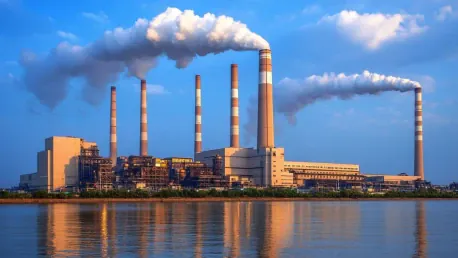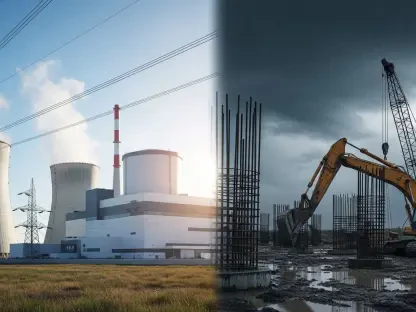In 2024, China embarked on a significant expansion of coal-power plant construction, marking the highest level of such activity in the past decade. This development, detailed in a report by the Centre for Research on Energy and Clean Air (CREA) and Global Energy Monitor (GEM), underscores a considerable challenge to China’s aspirations towards cleaner energy. The construction of 94.5 gigawatts (GW) of new coal-power capacity and the resumption of 3.3 GW of previously halted projects have raised critical concerns about the nation’s ability to meet its climate commitments.
China’s economy, heavily reliant on industrial production and export-led growth, continues to see coal as a reliable and cost-effective source of energy. The persistent use of coal remains a significant impediment to the reduction of carbon emissions and the transition to renewable energy sources. The tension between maintaining economic growth and achieving environmental sustainability is at the heart of these energy policy challenges.
Resurgence of Coal-Power Construction
China’s renewed focus on coal-power construction in 2024 is driven by the coal-mining sector, which sees this as a way to maintain stable demand for coal output. More than three-quarters of new coal-power projects were financed by companies involved in coal mining, aligning their strategies to sustain coal’s dominance, especially in major coal-producing provinces. This surge in construction is perceived as a significant undermining force against the progress in clean energy that China has been striving for.
The revival of coal-power projects is largely attributed to energy security concerns and the need to ensure a stable and continuous supply of electricity. The government, prioritizing energy security, has permitted the construction of new coal-power plants, overlooking its own environmental goals. The investments from the coal-mining companies have led to a stark increase in capacity, aiming to cater to regions with high industrial activity.
The rapid expansion of coal-power poses a substantial challenge to the nation’s climate commitments, including the pledge to reduce coal usage significantly. Analysts anticipate that China’s expansive clean-energy capacity initiatives will gradually diminish coal’s dominance in electricity production. However, the swift expansion of coal-power plants threatens to limit the ability of renewables to become the main source of electricity.
Impact on Clean-Energy Progress
Despite record installations of renewable energy sources, the increased coal-power capacity threatens to overshadow these advancements. The total solar and wind capacity reached a remarkable 890 GW and 520 GW, respectively, in 2024. However, the greater inclusion of low-carbon energy was anticipated to cut down coal’s share. The flurry of new coal construction poses a risk that renewable energy will be treated merely as a supplementary source, overshadowed by coal’s preeminence.
Several structural characteristics of the power system favor coal usage, such as long-term contracts that lock in coal supply and obligate provinces to use a certain amount, even when other energy sources might be more cost-effective. Additionally, policy structures ensure coal’s dominance by reducing the emphasis on renewable energy in power purchase agreements, contributing to an uneven playing field where coal remains insulated from risk, while wind and solar developers face financial and demand uncertainties.
One of the critical points made by experts is the risk of renewable energy sources being pushed to the margins while coal maintains a central role in China’s energy portfolio. While the renewable energy sector has seen significant growth, real change in the energy mix and policy structures is essential for renewables to thrive. Failure to transition energy systems could lead to renewed reliance on coal, impeding China’s long-term objectives.
Policy Recommendations and Structural Reforms
To counteract the growth of coal-power construction, CREA and GEM advocate for a range of policy measures that could realign China with its clean-energy goals. These measures include halting approval for new coal-power plants and pursuing reforms in the power market and grid systems. Effective policy changes and systemic reforms are necessary to align with China’s climate targets.
Addressing the root causes of coal’s dominance entails stringent policy directions, including setting ambitious targets for coal consumption reduction and accelerating the retirement of operational coal plants. Such efforts, combined with bolstered support for wind and solar energy development, could pave the way for meaningful progress towards a clean-energy future.
The developed new coal-power capacity might also limit the grid space available for renewable energy, complicating efforts for solar and wind to gain significant market share. This is evident from an increased curtailment of renewable energy, with a sharp rise in the final quarter of 2024. The report attributes this to structural constraints rather than the availability of solar and wind resources.
Systemic changes, such as restructuring long-term contracts to favor renewable sources and increasing incentives for clean energy investments, are pivotal in facilitating a transition away from coal. Power market and grid system reforms are essential to ensure a fair and competitive environment for renewables, enabling them to achieve a prominent role in China’s energy matrix.
Coal Industry Influence and Economic Interests
The core of the coal expansion is largely fueled by the mining industry, with coal-mining companies making significant investments in new coal-power projects to ensure stable demand for their output. Over three-quarters of newly approved coal-power projects were financed by entities involved in coal mining. This strategy aligns with China’s “dual-carbon” targets, yet paradoxically fuels coal’s sustained dominance, particularly in coal-rich provinces.
The strong backing from the coal industry indicates a persistent clout and influence over energy policy and project development. The 2024 resurgence in coal-power underscores the critical role that economic interests play in shaping China’s energy landscape, even at the expense of environmental sustainability goals.
The report stresses that the current growth in coal-power construction displays a continued momentum in coal project development, despite government intentions to strictly control coal usage. This signals that substantial new coal capacity is set to become operational in the coming years, solidifying coal’s role in China’s energy landscape. While new proposals for coal projects fell to 68.9 GW in 2024, suggesting a potential cooling, the resumption and continual approval of new projects indicate lingering strong support for coal.
Struggle for Clean Energy
There is a significant struggle between advancing renewable energy and the entrenched coal industry. Despite advancements in renewable energy installations, coal continues to receive significant policy and structural support, challenging the transition towards a cleaner energy system. The retirement rate of old coal plants is low, which exacerbates the retention of coal in the energy mix. This, coupled with new construction, is in direct conflict with President Xi Jinping’s pledge to limit coal consumption and with China’s 2030 carbon-peaking plan.
Forecasts indicate that the coal-power sector expects continual growth, which will likely cause unsustainable conflicts between China’s energy security needs and low-carbon policies. To counteract coal’s dominance, strong policy directions and reforms are essential. This could involve setting ambitious targets for reducing coal consumption, phasing down operational coal plants, and accelerating renewables’ adoption.
Balancing the imperative to reduce emissions alongside the necessity to support industrial growth remains a persistent challenge. Decisions made now will determine whether the trajectory of China’s energy system aligns with its national and international climate obligations or whether economic imperatives take precedence, delaying the transition to renewable energy sources.
Future Outlook and Challenges
China’s commitment to reducing carbon emissions and achieving carbon neutrality by 2060 faces significant hurdles due to this coal resurgence. Overcoming these challenges will require a determined effort to balance energy security with the urgent need for a clean and sustainable energy future. Long-term contracts, economic interests of the coal industry, and structural imbalances in the power market are substantial obstacles that need proactive policy interventions.
The continual growth in coal-power signals an ongoing struggle and underscores the necessity for systemic reforms and significant investments in clean energy infrastructure. Policymakers must address coal’s entrenched position with comprehensive strategies that include ending new coal-plant approvals, accelerating the retirement of existing coal plants, and promoting an inclusive and competitive environment for renewable energy investments. Effective regulation and incentives could drive significant progress towards a sustainable future while simultaneously supporting China’s energy security and economic stability.
Realigning China’s energy strategy requires integrated efforts from government entities, private sector stakeholders, and international cooperation to meet climate targets and secure a cleaner, sustainable energy pathway for the future.









